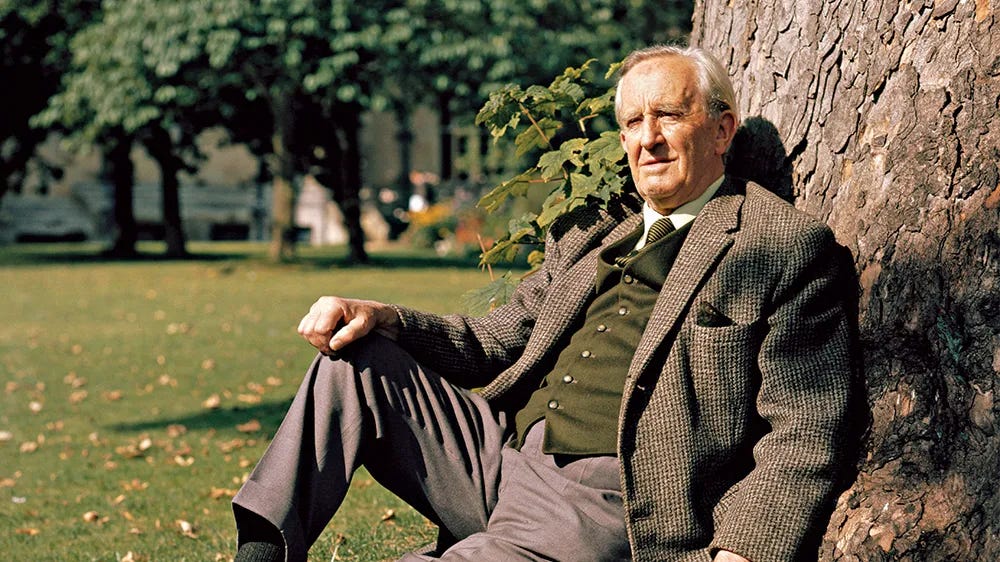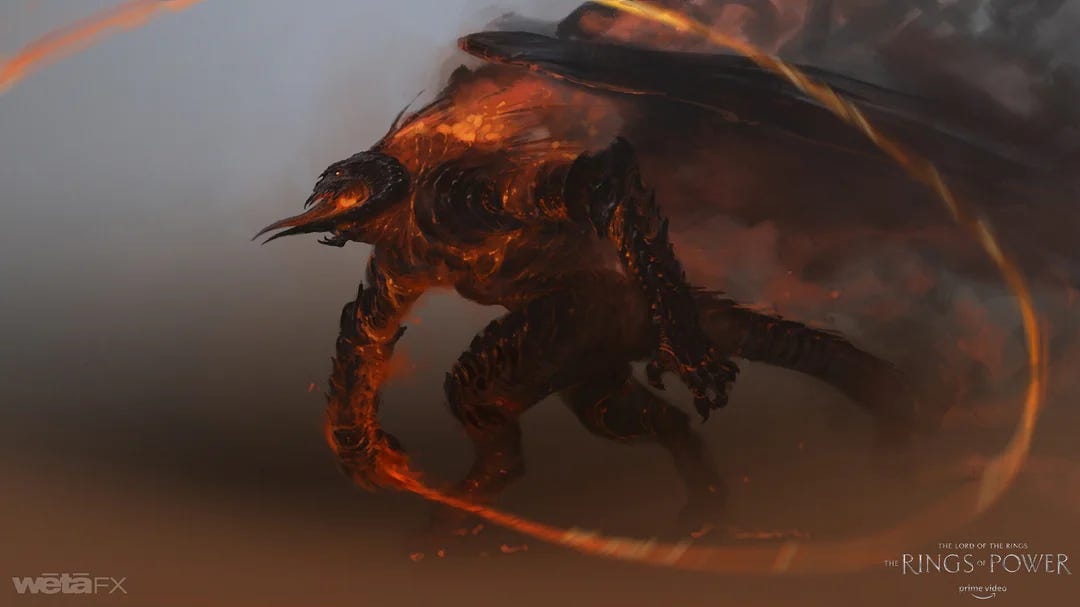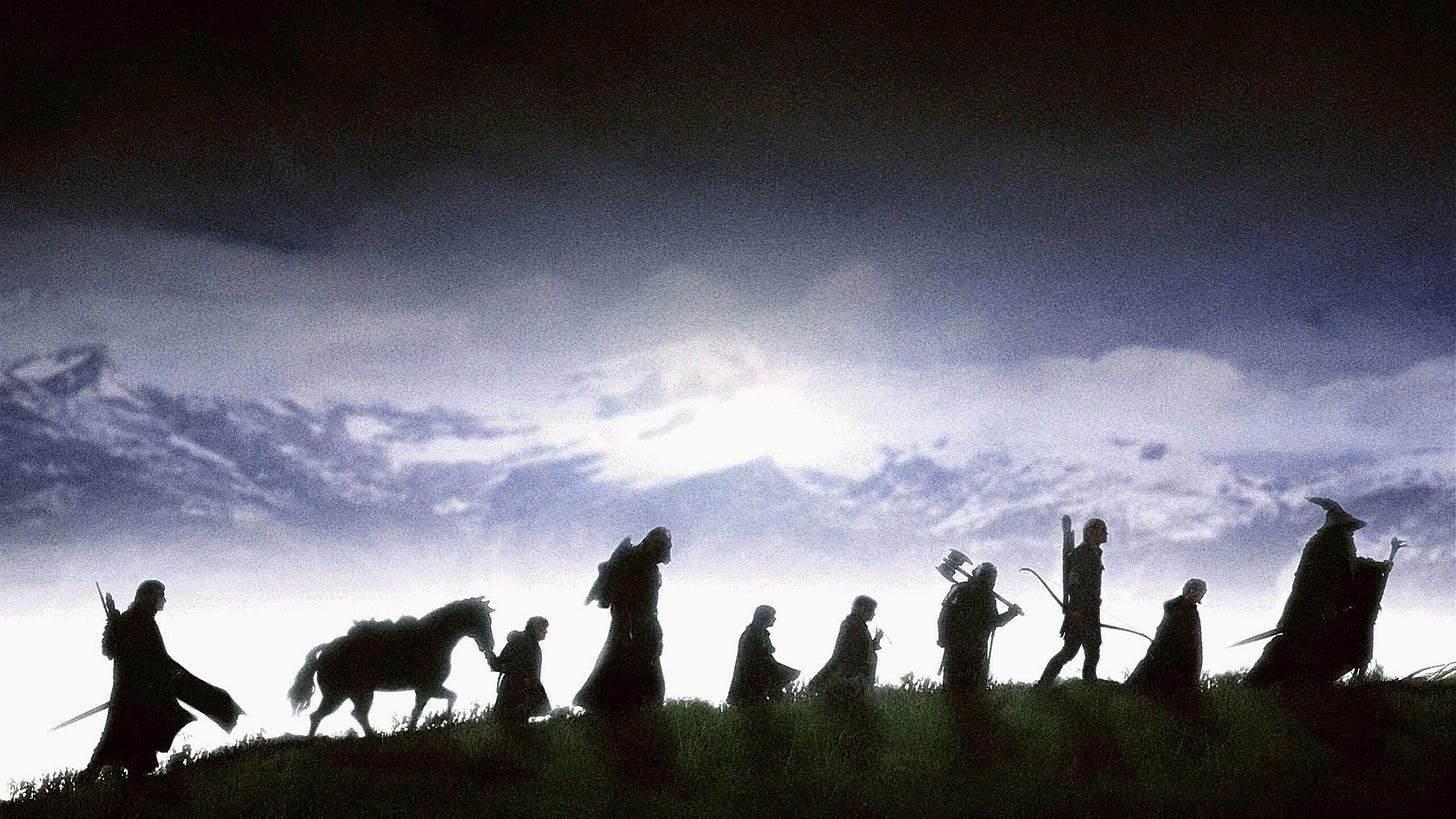10 Things I Learned from Tolkien
The hallmarks of epic fantasy cross all genres
Earlier this year I listened to JRR Tolkien’s The Silmarillion. More recently I devoured The Hobbit and the three volumes of The Lord of the Rings in sequence, all narrated masterfully by Andy Serkis. I read The Lord of the Rings about 15 years ago in New Zealand, and The Hobbit in my school days (see my previous post), but my re-immersion into Tolkien’s world was quite a different experience.
I was once again swept away by the richness of the narrative, the depth of the world-building, and the timeless themes that resonate as strongly today as they did when Tolkien first penned them. Certain sequences left me unexpectedly emotional: Boromir’s noble death, Théoden’s fall as witnessed through Merry’s eyes (for whom the king had become a father figure), and Sam’s bravery in the face of overwhelming odds. These moments, among many others, reminded me of the power of epic storytelling to move, challenge and inspire.
Tolkien’s work offers a wealth of insights for modern storytellers. Here are ten lessons I gleaned from the master of modern fantasy:
1. The Joy of Discovery: the Reader’s Desire to Learn
One of the most captivating aspects of Tolkien’s work is how it taps into the reader’s innate curiosity. While the characters’ desires, actions, and transformations drive the plot forward, there’s an additional layer of pleasure derived from simply exploring the world. Each chapter, each new perspective, each journey taken by the characters offers an opportunity to uncover more about this richly imagined realm.
This approach is reminiscent of video games and tabletop RPGs, where the joy of discovery is a core part of the experience. Tolkien weaves exposition into the narrative, revealing the history, geography, and cultures of Middle-earth through the eyes of his characters—the kind of showing-not-telling that would be verboten in most literature. For instance, the Council of Elrond serves not only as a pivotal plot point but also as an organic way to delve into the complex history of the One Ring and the various races of Middle-earth. It’s entertaining when, in most other genres, it shouldn’t be. But maybe that’s just the fantasy nerd in me.
2. The Power of Lore: Mythic Storytelling
Rather than presenting his world as a set of immutable facts, Tolkien filters our understanding through the perspectives of his characters and the accumulated wisdom (and potential misconceptions) of Middle-earth’s inhabitants. This approach, which I’d characterize as "lore over worldbuilding," lends a sense of authenticity and depth to the narrative.
For example, the nature of the Rings of Power is not presented as a dry historical fact, but as something shrouded in mystery, with different characters offering varying levels of understanding—even the narrator of the books feels like someone who only knows so much, just as historians of our world would come across to readers 10,000 years from now. This approach not only feels more realistic but also allows for a sense of discovery and revelation as the story unfolds.
Hey! Enjoying this piece? If so, do me a favour: share it with someone you think would dig it, and nudge them to subscribe. Like and comment on the post, too. I’d love to hear what you think!
3. The Art of the Episode: Chapter Structure
Tolkien’s mastery of episodic storytelling, which began in The Hobbit and matured in The Lord of the Rings, offers valuable lessons in narrative structure. Each chapter often presents a distinct challenge or adventure, coupled with the unveiling of a unique aspect (sometimes a creature like a troll or giant spider, sometimes a geographical feature like Weathertop or Helm’s Deep) of Middle-earth.
Take, for instance, the chapter “A Journey in the Dark” from The Fellowship of the Ring. It focuses on the Fellowship’s perilous journey through the Mines of Moria, introducing us to the ruined Dwarven kingdom while presenting the immediate threat of the Balrog. This structure allows Tolkien to explore different facets of his world while maintaining narrative momentum, and treating the chapter as a story-within-a-story with its own beginning, middle and end.
4. The Ensemble Cast: Multiple Perspectives
While The Hobbit primarily follows Bilbo, The Lord of the Rings encompasses a broader cast of characters. The narrative begins with Frodo but gradually shifts to include the perspectives of Aragorn, Merry, Pippin, Sam, Legolas, and Gimli. In fact, if I’m not mistaken, we only get Frodo’s direct perspective in The Fellowship of the Ring, and it is absent in the later two books.
The approach reminds me of George RR Martin’s A Song of Ice and Fire series (aka, Game of Thrones), which takes it to a whole other level of multiple, often competing protagonists. And similarly to Martin, Tolkien slowly expands the list of voiced characters, giving the impression of a deepening world and plot.
5. The Power of Anticlimax: Subverting Expectations
Tolkien’s use of anticlimax, particularly in the "Scouring of the Shire" chapter of The Return of the King, offers a masterclass in subverting reader expectations. After the epic confrontation with Sauron, we might expect the story to wind down quickly. Instead, Tolkien presents a final challenge that brings the narrative full circle and emphasizes the personal growth of the hobbits. It is signposted throughout the story, from Saruman’s interest in the Shire in The Two Towers, which makes this turn of events feel surprising yet inevitable.
This anticlimax serves multiple purposes: it shows the far-reaching consequences of the War of the Ring, demonstrates how the hobbits have changed, and provides a more nuanced resolution to the story. Tolkien famously said that his story was not allegory, but many commentators have noted that the chapter was rooted in England’s harrowing experience being bombed during the Second World War.
6. The MacGuffin: The Gravitational Pull of the One Ring
The One Ring is more than a simple plot device. Its nature and the logic surrounding it become the central organizing principle of the entire narrative. The need to protect it, the temptation to use it, and the quest to destroy it drive not just the plot, but shape the very themes of the story: the nature of power, corruption, sacrifice, despair and hope.
A well-conceived central element can provide coherence and depth to a complex narrative, and lend its logic to the logic of the unfolding story.
7. The Authenticity of Experience: Grounding Fantasy in Reality
Tolkien’s descriptions of landscapes, journeys, and even battles often feel remarkably authentic, rooted in real-world experiences. His depiction of the Dead Marshes, for instance, evokes the nightmare landscape of World War I battlefields, while his descriptions of natural beauty reflect his love for the English countryside.
This grounding in reality lends credibility to even the most fantastical elements of the story. It’s a reminder that drawing from our own experiences and observations can add a layer of authenticity to our work, regardless of genre, and even itself be interesting for the reader to tease out and resolve where specific inspirations were drawn.
8. The Iceberg Principle: Creating Depth Through Implied History
The depth of Tolkien’s legendarium is indeed legendary, encompassing thousands of years of history, multiple languages and intricate cultural details. However, what’s crucial is how this depth is presented in the narrative. Much like an iceberg, only a fraction of this information is directly visible in the text.
References to ancient legends, hints of long-lost kingdoms, and fragments of Elvish poetry create the sense of a world with a rich, complex history that extends far beyond the immediate story. This approach invites the reader’s imagination to fill in the gaps, creating a world that feels infinitely expansive. Sometimes, what's left unsaid can be as powerful as what's explicitly stated. Because of its sophistication and unfathomable depth (check out the Lord of the Rings Wiki or just read The Silmarillion to grasp the scope) we therefore might forget that we are in a fictional world and instead just accept the new reality.
9. The Eternal Hero’s Journey: Embracing Archetypal Narratives
The Lord of the Rings follows the classic hero’s journey structure. However, Tolkien’s adherence to this archetypal framework allows him to focus on enriching the story with complex characters, intricate plot threads and deep thematic resonance. By using a familiar structure, Tolkien creates a solid foundation upon which he can build layers of complexity. Fantasy author Brandon Sanderson advises writers who are trying to write a novel in a month (NaMoWriMo) to borrow such a structure to just move forward with what’s more important.
10. The Clockwork of Narrative: Timing and Structure
Tolkien paid meticulous attention to the timeline of events, which creates a sense of inevitability and coherence in the narrative. Events unfold with a sense of precise timing, coming together at crucial moments in ways that feel both surprising and inevitable.
While this sometimes borders on deus ex machina (the arrival of the Eagles is the classic example), Tolkien’s careful structuring keeps the plot tight and forward-moving. This is particularly impressive given the length and complexity of the work.
These ten insights barely scratch the surface of what we can learn from Tolkien. In the end, perhaps the greatest lesson is the power of passion and perseverance in storytelling. The Lord of the Rings was a labour of love, a work that Tolkien poured his heart and soul into over many years. It’s quixotic to think we can recapture it in shorter bursts or, in this case, a top-ten list. But I didn’t just want to read these books again for pleasure—I wanted to pull something out, and this is a start.
Writing
6/10. On the right path and feeling good, just not enough time to get a substantial amount of writing done.
Reading and Listening
Listened to both Diary of a CEO podcast episodes featuring psychiatrist and mental health coach Dr. Alok Kanojia (“Dr. K”): the first from March, the second from late September. Utterly fascinating and full of insights for which I had to hit pause and reflect. I might want to go through the transcripts of these episodes and pull out my thoughts and learnings—might be a future post!
Quote of the Week
“Tolkien has become a sort of mountain, appearing in all subsequent fantasy in the way that Mt. Fuji appears so often in Japanese prints. Sometimes it’s big and up close. Sometimes it’s a shape on the horizon. Sometimes it’s not there at all, which means that the artist either has made a deliberate decision against the mountain, which is interesting in itself, or is in fact standing on Mt. Fuji.“
― Terry Pratchett






Ben, I loved your writing about being "equal to the challenges of freedom".
I reflected, as I read that, rather than the sage "giving shape" (to other humans), I'd like to imagine each of us "giving space" to one another --within the challenges/potentialities of freedom. [Are there 'boundaries' to freedom that are baked into the challenge?] (I asked ChatGPT5 that question and the response floored me).
The older I get, the more I appreciate the deep and nuanced gift of the oral tradition. There is little in all of the humanities (to me) more riveting and reflectively inspirational than a good story, well told.
Peace and grace, r
Thanks Ben.
This is a very interesting article. It gave me something to think about. I’ll check out the interview.
Linda